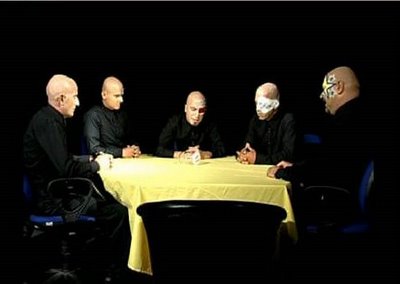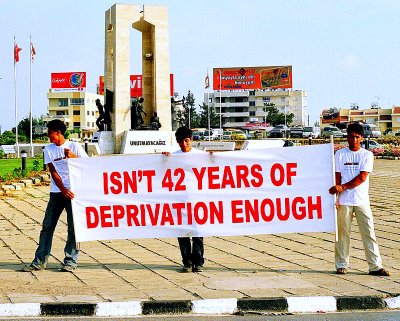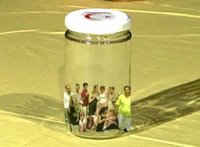Through the Looking Glass:
How Happy To Say I’m a Turk
< < Part 1: Remembering a Greek Tragedy
Someone shrank the Turkish Cypriots. They’re crammed into a bottle, pressing their hands against the glass walls. The bottle is surrounded by black-shirted giants with grease-painted faces that identify each of them as one of the great powers: Britain, America, the European Union, the United Nations. One of the giants suggests loosening the lid to give the Turkish Cypriots some air. A door swings open, revealing a shadowy figure. A well-known Turkish Cypriot actor—playing the Greek Cypriot leader Tassos Papadopoulous—enters the room and scolds them.
This advertisement played on all six television channels on the Turkish side of the island during the summer of 2005. It called on Turkish Cypriots to join a protest marking the anniversary of the coup on July 15th, 1974, when Greece attempted to take control of the island. But the sense of isolation and helplessness that the advertisement alluded to had more to do with the failure of the Annan Plan in 2004, which the Turkish Cypriots had overwhelmingly supported.
I watched this TV spot with Ergün Olgun, one of the protest organizers, in his spartan office at the back of his furniture store on the Turkish side of Nicosia. A few blocks to the south, on the Greek side of Nicosia, billboards reminded tourists that this was the last divided capital city in the world. But Nicosia is not Beirut. The Turkish side felt more like a small Midwestern American town in the 1950s—before The Gap, before Rite Aid, before Starbucks. What else would you expect after three decades when foreign businesses have shunned this part of the island?
Mr. Olgun spoke emphatically, punctuating many of his comments with sweeping arm gestures. “The theme of this ad is that we are a beseiged society, a caged society. We are under embargo. We are deprived of our political rights,” he said. While he described himself as a one-time advisor to the former Turkish Cypriot leader Rauf Denktash—who long promoted the idea of a separate Turkish Cypriot state—Mr. Olgun seemed to have come around to the idea of reunification, up to a point.
He said he supported the idea of Greek and Turkish Cypriot provinces under a federal government, which was the backbone of the Annan Plan. But Mr. Olgun didn’t seem entirely convinced of the plan’s viability. “Federalism can only work if there are strong mutual interests, a degree of trust and confidence. But the Greek Cypriots just believe that the Turkish Cypriots are a nuisance,” he said. A little while later, he compared the peace negotiations to a marriage, “do marriages hold together because you sign a piece of paper?” he asked rhetorically, adding that he just didn't see “the glue factor” between the Greek and Turkish Cypriot communities.
Mr. Olgun was planning the protest on July 15th, which he described as unofficial, and entirely separate from any Turkish Cypriot political parties. But the Turkish Cypriot leadership had it’s own festivities planned for July 20th. That was the day in 1974 when the Turkish Army landed in Kyrenia, on the north shore of Cyprus.
The Turkish Army has occupied north Cyprus since 1974. Every July 20th, while Greek Cypriots mourn the anniversary of the Turkish invasion, Turkish Cypriots celebrate the “1974 Peace Operation,” which was Turkey’s official name for this military campaign.
Huseyin Ozel, a spokesman for the Turkish Cypriot leadership, told me what to expect. There would be a parade, an air show, and a football match between politicians from north Cyprus and mainland Turkey. “It's like Bastille day,” he said, smiling earnestly and handing me a typed program of the day’s festivities.
Like other Turkish Cypriots, Mr. Ozel objects to refering to July 20th, 1974 as the Turkish “invasion,” which of course is what the Greek Cypriots call it. Turkish Cypriots say this was an “intervention” because Turkey was acting under the Treaty of Guarantee, after Greece—which was ruled by a militiary dictatorship at that time—tried to take control of the island in a coup d’etat.
Mr. Ozel was 16 when Turkish war planes filled the skies over Cyprus. He had grown up in the enclaves, where many Turkish Cypriots had barricaded themselves after the intercommunal strife in 1963. Greek Cypriots had kept a whole range of goods from reaching the enclaves. Mr. Ozel said the first time that he saw a banana was in 1974, after the TMT, the Turkish Cypriot militia, relocated Turkish Cypriots from the enclaves to the northern part of the island.
But what might have seemed like an improvement to Turkish Cypriots who were young thirty years ago feels stifling to their youth now. Many of the Turkish Cypriots in that TV spot looked too young to remember 1974.
tCr
(The first two photos are from a CD-ROM of the TV advertisement, which was provided by the International Council for North Cyprus, the group that organized the demonstration last year.)









0 Comments:
Post a Comment
<< Back to tCr Home